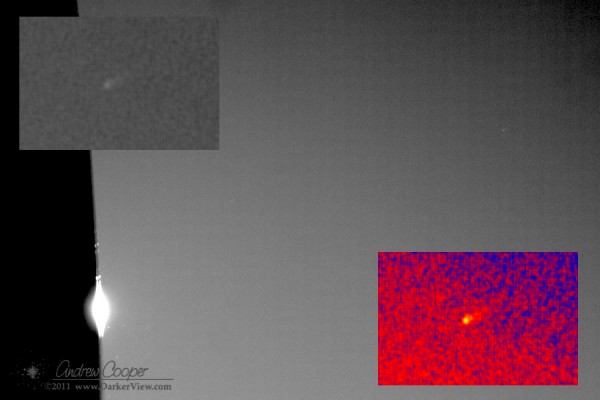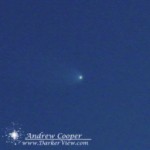I have been posting a lot of photos from others lately. Not something I do a lot of, I prefer to use my own shots. But when I get shots like this…

When you want to see the stars, find someplace dark
I did attempt to see comet C/2011 W3 Lovejoy in the daylight. I actually tried several times. Once on the morning of the 15th and a couple more times on the morning of the 16th after I heard that the comet had survived perihelion passage. Neither time did I see the comet with an unaided eye.
On the 15th I was not surprised I could not see it. I was in Waimea where there was a lot of low altitude haze and a lot of glare around the Sun. On the 16th I had a much better chance using the clean high altitude air of the summit of Mauna Kea. But still, no comet seen even though it should be just over four degrees from the Sun. This is about the same separation that had allowed me to see comet McNaught in early 2007.
Just to be certain I set the camera on a tripod, placed it just inside the shadow of the Keck 1 dome, and blazed away. Examining the photos on the camera display likewise revealed no trace of the comet, but there were some interesting spots of light.
It was not until I sat down and really analyzed the raw frames that I found something. Using some astronomy software, I calculated the position of the comet when the shots were taken and the field of view of the camera. And lo! There it was, a small spot with a trace of tail. It showed up best in the green channel, and not at all in the blue thanks to Rayleigh scattering in our atmosphere. Stacking nine of ten frames and processing the heck out of the frames does allow you to clearly see the comet…

Will Comet C/2011 W3 Lovejoy be visible in the daytime? This is the morning to find out. Look about 2° below the rising Sun once it is well up in the clear sky for a small white object. Two degrees is four times the Sun’s width in the sky.

I have seen one other daytime comet in my life, C2006/P1 McNaught back in January of 2007. That time the comet was about 5° from the Sun, over twice as far away from the glare. The photo at the right should give an idea of what to look for today. Remember to shield your eyes from the Sun’s glare by positioning yourself to put the Sun behind some object like a wall or streetlight. There is no guarantee that Lovejoy will be at all visible, but it is worth taking a look this morning.
The rumor is running around the various astronomy sites and listservers that Comet C/2011 W3 Lovejoy might be daytime visible. Will it be? That is a very qualified maybe.

It becomes a valid question to ask if comet Lovejoy will even survive perihelion transit.
Passing that close to the Sun will mean that the volatile elements of the comet will be streaming off the comet at a fantastic rate, enough to dramatically brighten the comet. Below you will find the ephemeris for perihelion on Dec 16th (Dec 15th HST) from the Minor Planet Center. As you can note, the predicted magnitude is -8! This is bright enough to be seen in broad daylight. Thus the possibility of a daytime comet.
The catch is that the comet will be quite close to the Sun. Within 2° as the Sun and comet rise on the morning of the 15th here in Hawai’i. For observers in the islands the best chance to look is on the morning of the 15th, as perihelion will occur in the afternoon as the comet passed behind the Sun from our point of view.
Will it be visible? Maybe. It depends on the accuracy of the magnitude estimates, which are uncertain to say the least. It could be substantially dimmer, or even substantially brighter than forecast under such conditions. The proximity to the Sun also complicates the issue. It is worth a look, seeing a daytime comet is highly unusual.
If you do look please take a few simple precautions… Do NOT use any sort of optical aid this close to the Sun, the risk of permanent eye damage is too great. If it is bright enough the comet should be a naked eye object. It will greatly help to position yourself to put the Sun just behind some obstruction. A building, a streetlight, anything to block the Sun’s glare and aid in picking out the comet. On the morning of the 15th the comet will rise 2° behind the Sun, thus 2° lower in the sky.
Give it a try!